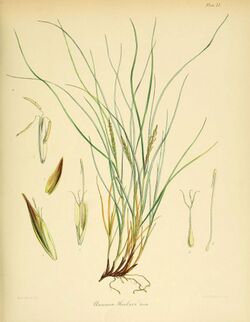Biology:Carex erebus
| Carex erebus | |
|---|---|

| |
| Plate LI (artist: Fitch)[1] | |
| Scientific classification | |
| Kingdom: | Plantae |
| Clade: | Tracheophytes |
| Clade: | Angiosperms |
| Clade: | Monocots |
| Clade: | Commelinids |
| Order: | Poales |
| Family: | Cyperaceae |
| Genus: | Carex |
| Species: | C. erebus
|
| Binomial name | |
| Carex erebus | |
| Synonyms[5][4] | |
|
Uncinia hookeri Boott | |
Carex erebus (common name - Hookers bastard grass)[5] is a member of the sedge family and is found on the Antarctic Islands of Australia and New Zealand.[3][5]
Distribution
It is found on Macquarie Island (Australia), and in New Zealand on Stewart Island, Antipodes Island, Auckland Islands and Campbell Island.[4]
Taxonomy
Carex erebus was first described in 1844 by Francis Boott as Uncinia hookeri in Joseph Hooker's Flora Antarctica.[4][1] In 2015, in order to make the genus Carex monophyletic, the genus, Uncinia, was sunk into Carex.[4] The name, Carex hookeri had already been published in 1837 for another species.[6] Hence a new species epithet was required: erebus was chosen, being the name of the ship (HMS Erebus) on which Hooker sailed on the Antarctic expedition of 1839-1843 when this species was first collected on the Auckland Islands.[4]
Conservation status
In both 2009 and 2012 it was deemed to be "At Risk - Naturally Uncommon" under the New Zealand Threat Classification System,[5] and this New Zealand classification was reaffirmed in 2018 (due to its restricted range) but with a further comment that it is secure overseas.[2]
References
- ↑ 1.0 1.1 Hooker, J.D. (1844). "Uncinia hookeri". The Botany of the Antarctic Voyage of H.M. Discovery Ships Erebus and Terror in the Years 1839-1843 :under the Command of Captain Sir James Clark Ross 1 (5): 91. https://biodiversitylibrary.org/page/3011429. Plate LI
- ↑ 2.0 2.1 de Lange, P.J.; Rolfe, J.R.; Barkla, J.W.; Courtney, S.P.; Champion, P.D.; Perrie, L.R.; Beadel, S.M.; Ford, K.A. et al. (2018-05-01). "Conservation status of New Zealand indigenous vascular plants, 2017". New Zealand Threat Classification Series 22: 41. OCLC 1041649797. https://www.doc.govt.nz/globalassets/documents/science-and-technical/nztcs22entire.pdf.
- ↑ 3.0 3.1 "Carex erebus K.A.Ford | Plants of the World Online | Kew Science". http://powo.science.kew.org/taxon/urn:lsid:ipni.org:names:77149559-1.
- ↑ 4.0 4.1 4.2 4.3 4.4 4.5 Global Carex Group (2015). "Making Carex monophyletic (Cyperaceae, tribe Cariceae): a new broader circumscription". Botanical Journal of the Linnean Society 179: 1–42. doi:10.1111/boj.12298.
- ↑ 5.0 5.1 5.2 5.3 "Carex erebus | New Zealand Plant Conservation Network". http://nzpcn.org.nz/flora_details.aspx?ID=1343.
- ↑ Kunth, C.S. (1837). Enumeratio plantarum. 2. p. 490. https://bibdigital.rjb.csic.es/viewer/11024/?offset=#page=493&viewer=picture&o=bookmark&n=0&q=.
External links
- Carex erebus images and occurrence data from GBIF
Wikidata ☰ Q43373548 entry
 |


